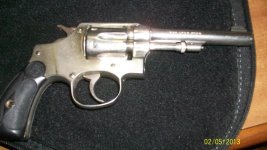Found this in the barter section on craigslist and got an e-mail off before the ad was flagged down. Guy doesn't seem to be a "gun person" or know much about the thing, so all I have is some cell phone pics to go on.
I can make out that it's a Smith and Wesson from the grips and the only part of the lettering I can see, but after that I'm at a loss as I'm not well versed in the handgun world. It would appear to my untrained eye that it's some manner of j-frame but I'd like to know just what I'm looking at before i make the guy an offer.
I can make out that it's a Smith and Wesson from the grips and the only part of the lettering I can see, but after that I'm at a loss as I'm not well versed in the handgun world. It would appear to my untrained eye that it's some manner of j-frame but I'd like to know just what I'm looking at before i make the guy an offer.

